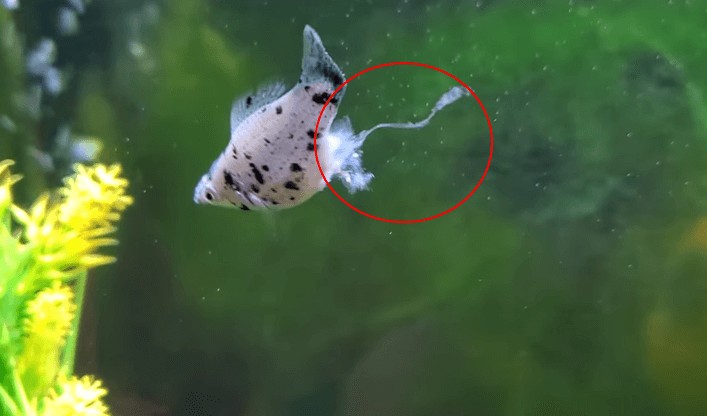The Molly fish is an immensely popular aquarium fish in freshwater aquariums. You can enjoy at least four mollies in an average medium-sized aquarium between 25-40 gallons. Colors ranging from orange, white, black, and even spotted versions will brighten up your tank.
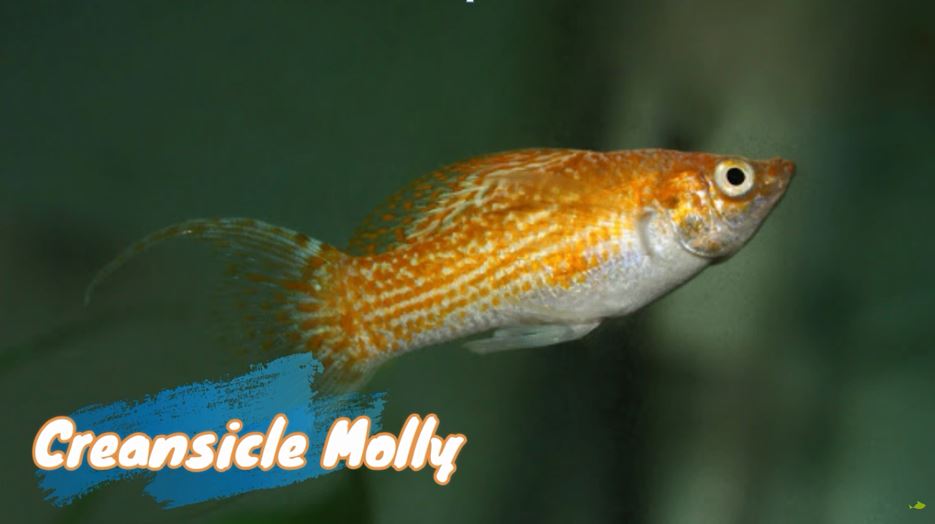
They don’t require any special water care and they even help you keep a clean tank by eating some kinds of algae. As a community fish, they won’t bother most other fish and will live happily in your tank for up to 5 years. Each molly will cost between $2-$10, so they are a great starter fish.
If you’re not ready to buy one just yet, let us show you how mollies will enrich your life and aquarium.
Contents
A/Molly Fish Features
Mollies will brighten up your tank and living space in a load of different ways. We want to show you how these fish can change your aquarium and become part of your family.
1-Mollies are Livebearers
How cool will it be to watch a fish give birth in your own tank? Mollies are an excellent breeder fish for beginners. People find success breeding mollies because they give birth to baby fish. The babies grow inside the molly until they are ready to swim. This keeps them safe and makes the breeding process much simpler.
Here’s a short video of a balloon molly giving birth to live young.
2-Mollies are Community Fish
One alpha male molly can live happily with up to three females. They aren’t overly aggressive towards each other and will not trouble other fish, either. Mollies aren’t huge fish. As long as you don’t put them in a tank with aggressive or large fish, they should be safe, happy, and colorful for years to come.
3-Mollies are Cleaners
Molly fish will eat some of the algae in your tank. They are not a complete algae solution, but they can help with soft or hair algae. This is the stuff that looks like green streams of hair growing on plants and decorations in your tank. Mollies will eat it up for you.
No fish is a substitute for proper tank maintenance. Mollies will clean up some kinds of algae, but you’ll still need to do regular water changes and clean the glass.
B/Molly fish size
Mollies grow to their maximum size of four inches in about six months. Male mollies are smaller than females and usually grow to only three inches. Females, being larger, grow an extra inch and have a more rounded abdomen.
Mollies give birth to live young, called fry. These small fish will grow through adolescence into full size within about six months. Fins continue to grow for longer and reach full brilliance and width by the end of the second year of life.
C/Types of Molly Fish
Mollies come in at least 39 different varieties. They have been bred for size, fin shape, and color. You can find a molly to suit just about any tank aesthetic you want. Here are our top seven choices for beautiful mollies for your tank.
1. Wild molly
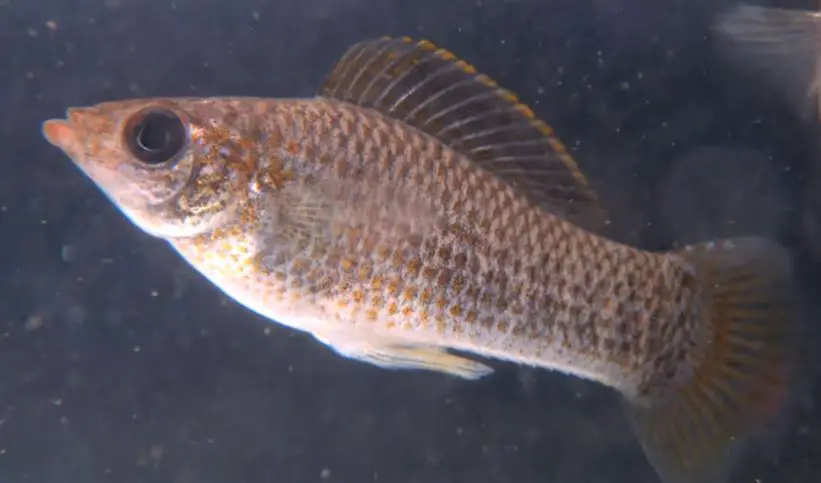
The wild molly is a beautiful little fish. Its body is silvery with green and brown highlights. The colors are more muted than some variations because predators can spot bright fish.
Wild mollies are long-lived and suffer no health problems due to selective breeding. Their fins are distinct and have highlight strips at the top and back of the fish.
2. Lyretail molly
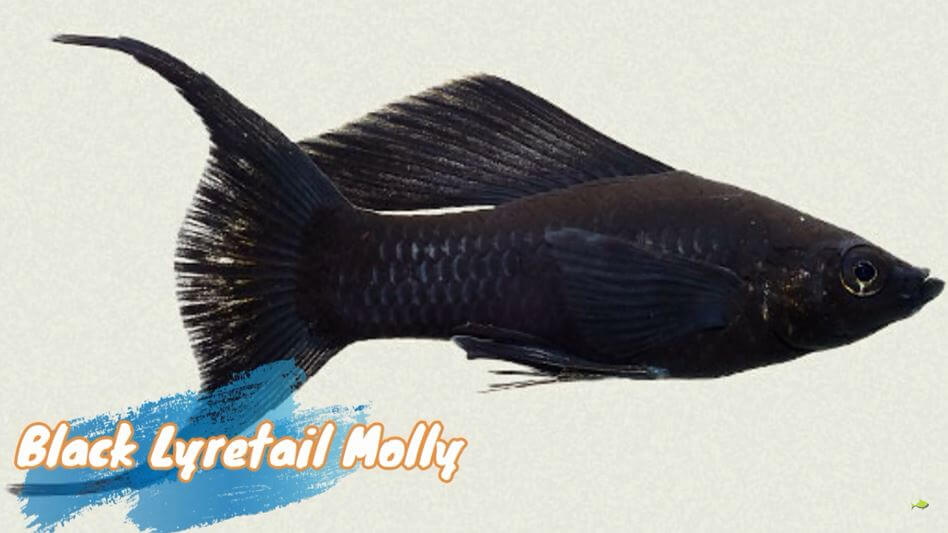
Lyretails have been bred for longer fins with points at the rear. The shape is from the lyre, an ancient musical instrument. Lyretails tend to swim more and want more space in the tank. This means using a bigger tank, but not by too much. Other than a little extra space, lyretails don’t have any special requirements.
3. Balloon molly

Balloon mollies generate a little controversy. These little beauties have been bred to have a spine that curves upwards and a belly that hangs lower, like a potbelly. Some people think this harms the fish or shortens their lifespan. However, balloon mollies are healthy and can live just as long as other varieties. They are a little bigger than other varieties and can come with a tail fin shaped like the lyretail.
4. Creamsicle molly

Creamsicles are gorgeous small fish. We call them Creamsicles because their orange and white scales remind us of the sherbet dessert called Creamsicles. Their bright orange dots merge with white scales to create a lovely texture. On their fins, the dots are more pronounced because the fins are more transparent. Creamsicles can have a lyretail shape as well.
5. Dalmation molly

These mollies are really striking with white scales and black dots. They resemble little dalmatians in your tank. They are active breeders and so you could end up with 101 dalmatians in a few months if you take care of the young ones. They usually come with a normal fin shape instead of the lyretail variation.
6. Gold dust molly

The gold dust molly is a fantastic fish to keep in heavily planted tanks where its gold and black coloring can show off.
Under good lighting, the fading gold from the mouth to a black tail will look amazing. Gold dust mollies can be bred to have a lyretail shape or a more natural wild molly fin shape.
7. Sailfin molly

Sailfin mollies are a big change from the other varieties. Their dorsal fin is elongated and looks like the long fin on top of sailfish. Sailfin mollies come in different color varieties but the most common is a silver and black spotted version. They are great swimmers and don’t have any extra care requirements.
D/How to Take Care of Molly Fish
We’ve already said molly fish are easy to care for and they don’t require any special water parameters. Freshwater tanks have these water parameters:
| Temperature | 72°-82°F or 22°-28°C |
| Ammonia | 0 ppm |
| Nitrite | 0 ppm |
| Nitrate | <50 ppm |
| General Hardness (GH) | 4-12 GH |
| Carbonate Hardness (KH) | 4-8 KH |
| pH | 6.5-8.5 |
Some tanks may be a little colder than this or have slightly lower/higher pH. These general figures will suit most freshwater tanks.
Mollies will thrive in tanks with these parameters. The only optional equipment you could supply is a water heater to keep the temperature a little warmer for them.
1-Water Quality
Molly fish will survive in a freshwater aquarium within the parameters of the table above. However, you can tweak the parameters a little to make them happier. Here are a few things you do to help them:
- Mollies like slightly warmer water. Using a heater to keep the water closer to 78°F (~26°C) will make your mollies happier. They will also be more likely to breed in warmer water.
- Mollies also prefer water with a higher pH. Aiming to keep your pH level closer to 7.5 or even 8.0 will be better for your little friends. >>Read more: Fish Tank Water pH – The Full Guide for Beginners
- Mollies can adapt to salt water for short periods of time. If your fish seem unwell, then a quarantine tank with a slight boost of aquarium salt may help them get better.
2-How to Feed Molly Fish
Drop acceptable food in the tank. These omnivores eat almost everything, so they don’t need any special kinds of food. They do seem to eat constantly, so you’ll have to resist the temptation to feed them too much.
What to Feed Molly Fish?
Mollies are omnivores. They eat everything. There are different categories of food you can give them. Here’s a little breakdown of the different food types and what you can feed your mollies.
Fish Pellets or Flakes
Manufactured foods are great for your fish because they contain all the nutrients and minerals your fish need to grow.
You don’t need to feed a large volume because manufactured food is very dense compared to natural food. Natural foods can contain as much as 85% water.
Pellets and flakes might have a water content of 5%-10%. These nutrient-dense foods are easy to use, healthy, and cheap.
Live Food
Mollies love to eat live foods. You can feed them with common live food bought from your local store or online.
Tubifex worms are a popular choice but you should only buy them from reputable sources, or they can carry diseases. Brine shrimp and daphnia (water fleas) are other great choices.
>> You can also click HERE to view Instant Baby Brine Shrimp product on Amazon.
Natural Foods
You can feed your fish many kinds of natural foods and create your own on a budget. Mollies like vegetables. Try blanching (boiling for just a few minutes) some lettuce or spinach. Shred it finely and then feed it to your fish. Watch the veggie feast!
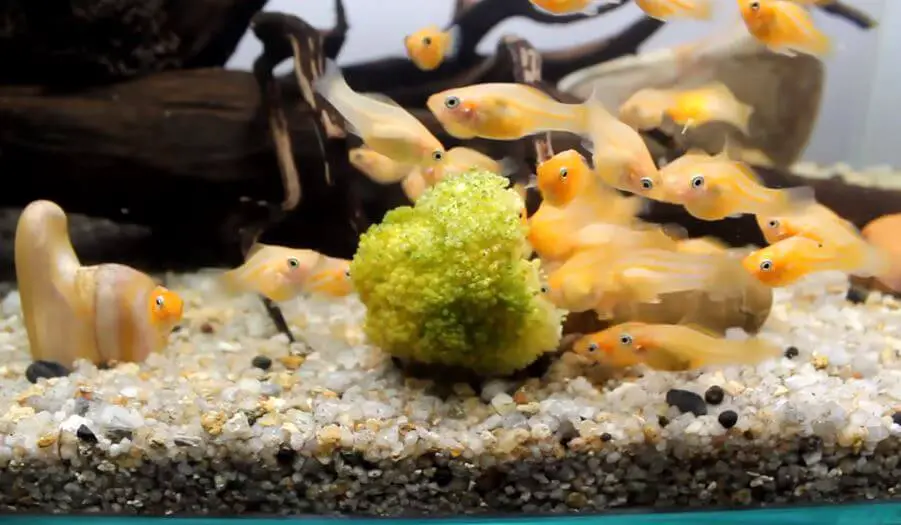
You can also do this with egg yolks that have been boiled and then crumbled.
How Much Should They Be Fed?
Most people are tempted to feed their fish too much because the little swimmers always seem hungry. Fish will generally keep eating even when they have had enough.
Here’s the simple way to know the right amount to feed your fish:
If you try this and your fish eat all the food too quickly, then give them some more food. If too much food is left behind, then try to clean it out with a net or filter and use less food next time.
Use this method to get the correct amount to use in one feeding session. Then feed your fish once or twice a day. Fish usually take 24 hours to digest their food, so feeding them more than twice a day is probably overfeeding them.
Overfeeding your fish can cause two problems:
- It is bad for your fish and can make them unhealthy.
- It is bad for your tank because the extra food and waste is converted into ammonia.
Follow our simple rule and your fish will be well-fed and happy.
3-Molly Tank Setup
Setting up molly fish tanks is really simple because they don’t need anything special. They can live in any good-sized tank with other fish, plants, and decorations. Let’s just add a few more details so you know how to get started.
Tank Mates
Mollies are peaceful fish and can live happily with other similarly sized fish. Mixing bigger fish with smaller fish almost always results in fish being eaten.
So, you can keep mollies with other fish the same size such as Cherry Barbs, Corydoras Catfish, Tetras, Loaches, Guppies….
Molly Group Sizes
Mollies are friendly and live together in schools. However, a single alpha male molly should be kept with two or three females. This stops them from being too aggressive towards the females. Multiple schools of mollies can be kept in a single tank if there is enough space for them all to swim around.
Molly Tank Size
Keep your mollies in a tank with at least 1 gallon for every inch of fully-grown fish. A full school of mollies – one male and three females – needs about fifteen gallons of water. So a common medium-sized tank of 25 or 30 gallons could be used for two schools of mollies or one group of mollies and 10 tetras.
Tank Plants and Decorations
Mollies don’t need decorations or plants to survive, but these features are much better for them. Mollies can eat plants as food. They also use plants and decorations as hiding places when they feel stressed or threatened. When they are ready to bear young, plants and decorations can be spawning areas and shelter for fry.
E/Summary
We love molly fish and hope you can add some to your tank. They are gorgeous, easy to care for, and you can even breed them for pleasure or money. Have a look in your local fish store or buy a school online.

